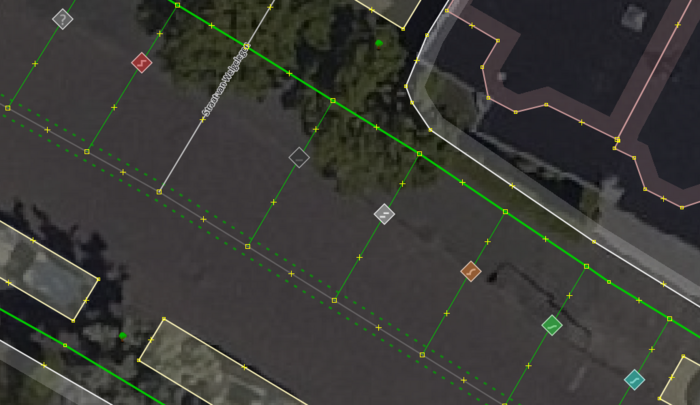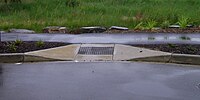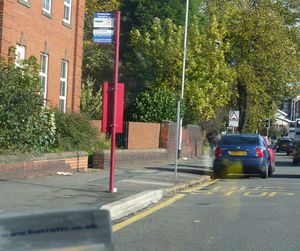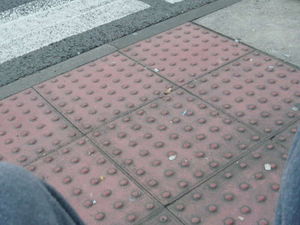Key:kerb
| Description |
|---|
| Used to indicate height and thus accessibility of a kerb. |
| Group: highways |
| Used on these elements |
| Useful combination |
| Status: de facto |
| Tools for this tag |
|
A kerb (American English curb) is the edge where a road meets a sidewalk or in similar situations (e.g. around traffic islands). As these are transition points between different surfaces and/or elevations, the locations of kerbs are important features to pedestrians, cyclists, and especially to those with reduced mobility (e.g., in wheelchairs).
The kerb itself is most commonly mapped using barrier=kerb. The key kerb=* described on this page is about adds information about the kerb and it varies in meaning depending on where it is used (see below).
Note: As a matter of convention OSM uses ![]() British English terms for most tags in preference to
British English terms for most tags in preference to ![]() North American English, in this case, kerb=* rather than curb.
North American English, in this case, kerb=* rather than curb.
Usage
As a subkey of barrier=kerb
On a way
The kerb itself can be mapped as a way tagged barrier=kerb along the length of the kerb. Optionally, kerb=* can be used to provide additional information about the type or approximate height of the kerb (see values below). The exact height of the kerb is most commonly mapped using height=*, though kerb:height=* is also sometimes seen on ways.
On a node
barrier=kerb is also used on nodes at the exact location where a highway crosses the kerb. kerb=* can be used to provide additional information about the type or approximate height of the kerb (see values below). On nodes, the exact height of the kerb is most commonly mapped using kerb:height=*, though height=* is also sometimes seen.
As an example, at a pedestrian crossing, the footway=crossing way might cross a kerb that has been lowered to facilitate wheelchair access; the node at the point where the kerb crosses the path should be tagged with barrier=kerb and kerb=lowered. There are also examples of service roads, especially driveways, that cross the kerb and even for minor regular roads, in some areas there may be a kerb where it joins a more important road[1].
By itself
The key kerb=* is also sometimes used by itself on a node at the exact location where a highway (such as a highway=footway or highway=path) crosses the kerb (e.g., a curb cut). When encountering this usage, it is advisable to add barrier=kerb to avoid confusion with other uses of the key kerb=* (see below).
kerb=raised is sometimes encountered on its own on nodes where one might expect a pedestrian crossing, because a path, footway or similar meets a road, but the kerb is not lowered to help pedestrians cross. In the past the tag was used this way by StreetComplete[2] but this usage was not without controversy because it is easily confused with other uses of the key kerb=* on nodes. The tag barrier=kerb should not be added at such a point even if it is suggested by an editor, because the node is also part of the road, so it would mean that someone travelling on the road (e.g. a car) also has to cross the kerb. As of late 2023, crossing=informal is a new, less controversial tag for the same situation, that is, it is neither impossible or illegal for a pedestrian to cross the road at this point (which would be crossing=no) nor is there infrastructure that makes it easier for pedestrians to cross the road here, such as road markings or a pedestrian island (which would be highway=crossing). When encountering kerb=raised used as described here, consider replacing it with crossing=informal where appropriate.
To add information to another map feature
kerb=* is also used on a highway=crossing, highway=bus_stop or similar to provide information about the kerb at this point. This usage indicates that there is a kerb somewhere near this node that someone visiting the node might want to know about, but it does not imply that everyone visiting this point has to cross the kerb, so barrier=kerb should not be used on such nodes. (In fact, a raised kerb at a bus stop may exist to make it easier for people to get on the bus.)
On crossings, the use of kerb=* on the highway=crossing node is an alternative to placing two barrier=kerb on each side at the actual location of the kerb (e.g., due to a lack of high resolution imagery or because the crossing path is intentionally not mapped separately as a highway=footway – see Sidewalks for reasons why one might prefer either approach). If you place separate barrier=kerb nodes, please remove the kerb=* tag from that node (otherwise a router might think that there are four kerbs to cross).
You can use kerb:left=* and kerb:right=* if the kerbs differ, with left and right referring to the way that is being crossed.
Values
Possible values for kerb=* are shown in the table below. The heights given here are only indicative; choice of a particular value should depend solely on functional considerations. In other words, it is better to consider wheelchair accessibility than the specific height of the kerb when choosing a value.
These documented values imply wheelchair=yes or wheelchair=no; this means you can omit wheelchair=* unless its value differs from the implied value below.
| Value | Typical height | Implies | Typical use | Description | Example |
|---|---|---|---|---|---|
flush |
~0 cm | wheelchair=yes | Crossings & driveways | Similarly to lowered, except the level transition is unlikely to be apparent, to blind users, by tactile sensation.
It is important to map tactile paving at these locations. |
|
lowered |
~3 cm | wheelchair=yes | Crossings & driveways | Lowered kerbs are often found at crossing and driveways. They help ensure the crossing can be used by wheelchair users and allow access to drives.
Some names for objects that fall into this category include driveway apron, curb cut (U.S.), curb ramp, dropped kerb (UK), pram ramp, and kerb ramp (Australia). Use this as a replacement for sloped_curb=yes or both. |
|
no |
— | wheelchair=yes | No kerb is present. This can be useful to make it clear there is no kerb present — because there used to be a kerb, or a kerb would otherwise be expected (e.g., because it looks like one might be present judging from aerial photography). | ||
raised |
>3 cm | wheelchair=no† | Bus stops & older kerbs | High kerb. Height results in noticeable trouble for wheelchair and bicycles trying to pass it. In many places it falls foul of modern norms for crossings. Typical at bus stops to provide at-level access on and off buses (where you might also want to tag kerb:approach_aid=*).
At least in the US, this is also the most common kerb at footway crossings before recent accessibility regulations came into existence. Note that the primary feature of Kassel kerbs, used at bus stops, is contouring to alleviate tyre rubbing when buses stop (not having a raised level), which is not specifically mapped. †: When used on pedestrian paths it implies wheelchair=no (and may be used to increase the cost of travelling over this kerb by bicycle). Consider adding wheelchair=limited if the kerb is <7 cm high. This value can also be added to the highway=bus_stop node or platform node/way — in that case it would not imply wheelchair=no. |
|
rolled |
— | wheelchair=no | Residential streets | Rolled kerbs provide a gutter for water while being traversable by large wheeled vehicles, such as cars and bicycles, but not wheelchairs. They are generally used in lightly trafficked areas, such as planned residential areas, being insufficient for commercial or industrial roads.
Do not confuse with kerb=lowered, which are traversable by wheelchairs. |
|
yes |
any | wheelchair=no‡ | Some sort of kerb is present, but it can't or hasn't yet been determined whether it is raised, lowered, flush, etc. This may be useful when mapping via aerial imagery (prior to field survey) or if the exact type of kerb can't be recalled.
‡: Cautious routers could consider this to mean wheelchair=no, so whenever possible this value should not be used other than on a temporary basis. |
Kerb height
If the exact height of the kerb is known this can be marked using kerb:height=* (or, in the case of barrier=kerb ways, height=*). Measurements of height and width are specified in metres by default (i.e., when the unit is omitted); state the unit used in the tag if you want to use centimetres or inches instead.
Some examples:
- 0.12 – a 12 cm high kerb, noted in metres.
- 4 cm – a 4 cm high kerb.
- 6" – a 6 inch high kerb.
Examples
| Type | Tagging |
|---|---|
| Red nodes are tagged with barrier=kerb and kerb=lowered, crossing ways are marked with highway=footway and footway=crossing, crossing nodes are tagged with highway=crossing and crossing=traffic_signals. | |
| Add to either the bus stop or the platform kerb=raised. Do not add barrier=kerb. It is assumed the kerb tag refers to the edge between the road and the platform. If you wish to explicitly map, tag the actual kerb as a way on the platform area. | |
| Add to either the bus stop or the platform kerb=raised alongside kerb:approach_aid=yes. Do not add barrier=kerb. It is assumed the kerb tag refers to the edge between the road and the platform. If you wish to explicitly map, tag the actual kerb as a way on the platform area. | |
| Use barrier=kerb and kerb=lowered on the nodes of the footway at the locations of the kerbs. Assuming both sides of the crossing are the same, kerb=lowered could instead be added to the crossing node (without barrier=kerb). | |
| Use barrier=kerb and kerb=flush and tactile_paving=yes on the nodes of the footway at the locations of the kerbs. Assuming both sides of the crossing are the same, kerb=flush could instead be added to the crossing node (without barrier=kerb). |
Related tags
The kerb=* node can also be tagged with tactile_paving=* to assist vision impaired individuals, and is especially important on kerb=flush nodes.
Editing with JOSM
In JOSM the Map Paint Style Sidewalks and footways (with knobs on) can be used to visualize kerb=* when used on nodes ![]() :
:

Possible tagging mistakes
See also
- kerb:approach_aid=* - for tagging whether there is additional approach aid for busses on kerb=raised
- Steps features
- Tactile paving
- Forward & backward, left & right
- Barrier
- Wheelchair
- barrier=step - Steps are physically similar to kerbs but aren't used next to roads.
- Proposed features/Traffic island, traffic_calming=island and crossing:island=* are features that have kerbs in the middle of roads.
- Relations/Proposed/Area
- Proposed features/sloped curb, an older, simpler proposal to tag flush kerbs.
- Proposed features/kerb=regular where kerb=regular and redefinition of kerb=raised was proposed and rejected
External links
- Many of the recommendations on this page are the result of a community discussion on how kerb=* is and should be used
- Wikipedia articles on kerb, and curb cut
- FHWA: Designing Sidewalks and Trails for Access, Chapter 7. Curb Ramps - From the US Federal Highways Administration, more than you could ever want to know about curb ramps. Other chapters from this guide might also be useful.












